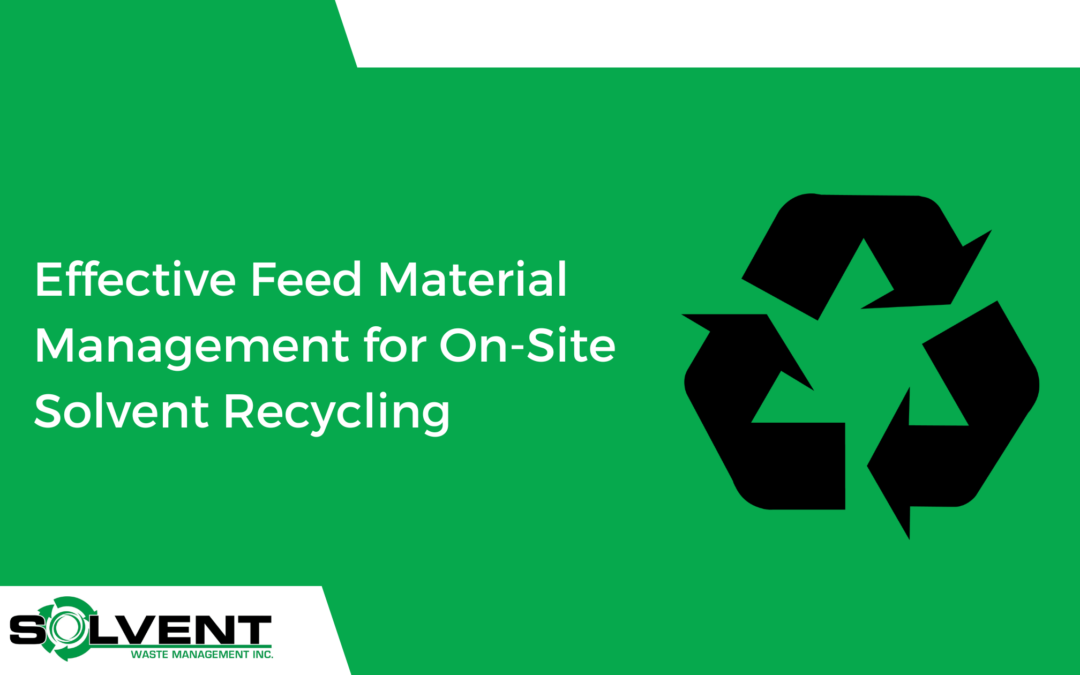Managing the feed material for on-site solvent recycling is a critical aspect of establishing an efficient and successful recycling program. The feed material refers to the solvents that will be collected and processed for recycling purposes. Proper management of the feed material ensures the quality and effectiveness of the recycling process, leading to reduced carbon emissions and cost savings. In this article, we will discuss essential guidelines on how to effectively manage feed material for on-site solvent recycling.
Introduction
Efficient feed material management is vital for the success of on-site solvent recycling programs. It involves evaluating, segregating, monitoring, and handling the solvents used within your operations. By implementing effective management practices, you can optimize the recycling process, minimize risks, and ensure the highest quality of recycled solvents.
Importance of Managing Feed Material
Proper management of the feed material provides several benefits:
- Quality Assurance: By evaluating and segregating solvents, you can ensure that only suitable solvents are processed for recycling. This improves the quality of the recycled solvents, making them more effective for future use.
- Safety and Compliance: Managing feed material involves adhering to safety protocols and complying with regulatory requirements. Proper handling and storage of solvents reduce the risk of accidents, spills, and environmental contamination.
- Efficiency and Cost Savings: Effective feed material management minimizes the processing of unsuitable or contaminated solvents, optimizing the recycling process. This improves overall efficiency and reduces operational costs.
Solvent Evaluation and Segregation
Identification and Classification
Start by identifying and classifying the solvents used in your operations. Understand their chemical composition, properties, and potential hazards. Create a detailed inventory of the solvents to streamline the evaluation and segregation process.
Compatibility Assessment
Evaluate the compatibility of different solvents to avoid reactions or contamination during storage or recycling. Segregate solvents based on their compatibility groups to prevent accidents or compromised quality. Consult safety data sheets (SDS) and chemical compatibility charts for guidance.
Segregation and Storage
Segregate solvents into dedicated storage areas or containers based on their compatibility. Use clearly labeled containers that indicate the type of solvent and any associated hazards. Ensure proper ventilation, temperature control, and appropriate safety measures for storage areas.
Monitoring and Quality Control
Sampling and Testing
Regularly sample solvents to assess their quality and suitability for recycling. Follow established sampling protocols and collect representative samples. Perform testing to identify any impurities, contaminants, or degradation that may affect the recycling process.
Quality Assessment
Establish quality control measures to evaluate the feed material’s suitability for recycling. Define acceptable quality parameters based on industry standards and regulatory requirements. Implement a quality assurance program that includes regular testing and analysis.
Handling and Transportation
Safety Precautions
Train employees on proper handling procedures and safety precautions when working with solvents. Use personal protective equipment (PPE) as necessary and provide appropriate safety training to reduce the risk of accidents or exposure.
Proper Containers and Labeling
Use suitable containers for storing and transporting solvents. Ensure containers are compatible with the solvents being handled and properly labeled with relevant information such as the solvent name, hazards, and handling instructions.
Storage Considerations
Store solvents in designated areas with proper ventilation, temperature control, and fire safety measures. Follow local regulations and guidelines for storing hazardous materials. Regularly inspect storage areas for leaks, spills, or signs of degradation.
Transportation Guidelines
When transporting solvents for recycling, adhere to transportation regulations and guidelines. Secure containers to prevent spills or accidents during transit. Use appropriate vehicles and packaging materials to ensure the safety and integrity of the feed material.
Training and Education
Provide comprehensive training and education to employees involved in the management of feed material. Ensure they understand the importance of proper solvent handling, segregation, and storage. Regularly update training programs to incorporate new regulations or best practices.
Conclusion
Efficient management of feed material is crucial for the success of on-site solvent recycling programs. By implementing proper evaluation, segregation, monitoring, and handling practices, businesses can optimize the recycling process, ensure safety and compliance, and achieve cost savings. Remember to stay updated with regulatory requirements and industry best practices to continuously improve your feed material management.
FAQs (Frequently Asked Questions)
- Q: Why is solvent evaluation important in feed material management?
- A: Solvent evaluation ensures that only suitable solvents are processed for recycling, improving the quality of the recycled solvents.
- Q: How can I determine the compatibility of solvents?
- A: Refer to safety data sheets (SDS) and chemical compatibility charts for guidance on solvent compatibility.
- Q: What are some safety precautions when handling solvents?
- A: Wear appropriate personal protective equipment (PPE), ensure proper ventilation, and follow established safety protocols.
- Q: How often should solvents be sampled and tested?
- A: Regular sampling and testing should be conducted to assess the quality and suitability of solvents for recycling.
- Q: What training is necessary for employees involved in feed material management?
- A: Employees should receive training on proper solvent handling, segregation, storage, and transportation procedures.

